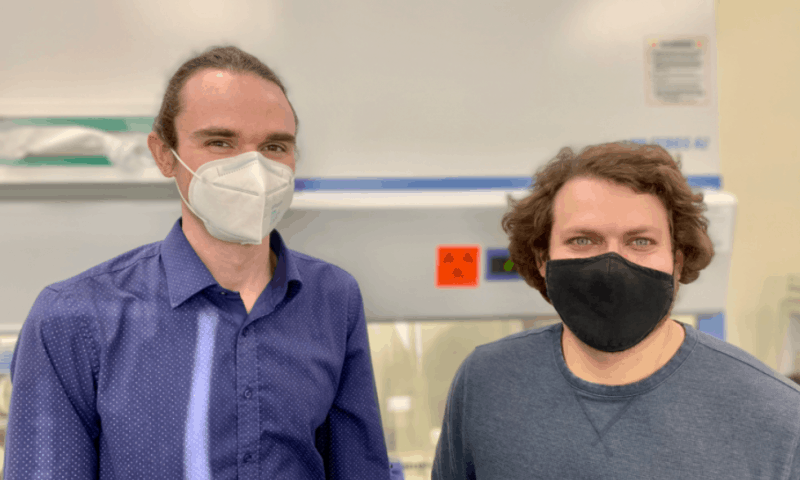Cancer drugs stop working when malignant cells develop molecular changes that allow them to evade the drugs’ effects. As a result, cancer treatment typically requires multiple phases, where patients start with the standard of care and then move onto second-, third-, or even fourth-line therapies as their cancer outsmarts each drug.
The problem with this approach is that it’s reactive. It requires waiting for cancers to develop mutations or other resistance mechanisms to sidestep each drug and tackling those mechanisms as they come. But what if doctors could instead combine multiple drugs into one treatment, such as a pill, that would head off any and all resistance mechanisms a cancer might develop?
“We’re focusing on getting the cancer to reveal resistance mechanisms inherent in each cell of the tumor,” said Nick Goldner, Ph.D., CEO and co-founder of resistanceBio, a biotech company working to develop treatments that target resistance.
“Our goal is to identify a therapeutic course that treats a tumor in its current state and as it evolves over time,” Goldner added. “We are looking for multitargeted therapeutics that expose multiple different resistance mechanisms and target susceptibilities all at once.”
The ideal product would be a single treatment that has a fixed ratio of therapeutics, though the company isn’t ruling out the possibility that its treatments may involve some degree of drug cycling, or using multiple medicines sequentially, said Chris Bulow, Ph.D., chief operating officer and co-founder of resistanceBio.
It’s an approach Goldner and Bulow explored in their doctoral research in anti-infective medicine. The same way a reservoir of drug-resistant bacteria might survive a course of antibiotics, a drug-resistant group of cancer cells can persist even as a treatment wipes out other, nonresistant cells in the tumor. These leftover cells can then multiply, unhampered by the initial treatment.
“It comes down to tumor heterogeneity,” Goldner said. Cancer cells aren’t created equal and can have many different genomic or metabolic profiles even within the same tumor.
Beginnings in anti-infectives
Goldner and Bulow started a company called Viosera to focus on treatments for bloodstream infections in 2016. They found their way to Y Combinator in winter 2019 and soon understood their approach could be applied to diseases beyond bacterial infections.
They started cancer-focused resistanceBio in early 2021 and are still involved with Viosera, though the plan is to pass the baton of the anti-infectives company to a new team soon. Along the way, the duo has raised $5.5 million and plans to raise a series A round this year.
The company started its oncology journey by seeking data sets on which to build a model of how tumor drug resistance evolves.
But there was one issue. “It turned out there were not good longitudinal data sets in oncology of how resistance evolves to a single therapy or course of therapy over time, so we created our own system that lets you look at a tumor in a large population of cells with controlled drug exposure,” Bulow said.
Modeling treatment resistance in cancer
ResistanceBio designed a cell culture system, dubbed ResCu, that mimics the size and diversity of human tumors to model how cancer responds to a given drug and finds ways to evade it. It uses computational models to understand how cancers escape each drug and how each individual component of a treatment affects different kinds of cells in the tumor.
With its system, the company can take a drug known to be effective in certain types of cancers and figure out the ways through which those cancers can become resistant to treatment, Goldner said. By doing this, it can generate and characterize this new population of resistant cells.
“We figure out what the weaknesses are that the resistance has created. From there, we screen for ways to overcome that resistance and identify new targets and new therapies that proactively address that resistance mechanism,” he said.
From there, it’s rinse and repeat until there is no longer a drug-resistant group of cells that persists.
“It’s an iterative process to make sure what we put through the clinic is most effective,” Goldner said.
Plans for programs and partnerships
So far, the company has studied targeted therapies in non-small cell lung cancer and colorectal cancer, using its technology to predict the types of resistance mechanisms the tumors will develop. It’s done so with approved medicines as well as those still in development. The company hasn’t yet published the results of those efforts but is working with its scientific advisory board to do so.
“The ResCu platform is fairly mature and we’re in the process of automating it. We’ve gotten two potential assets out of it, targeting non-small cell lung cancer and colorectal cancer and we are exploring potential partnering opportunities for those assets,” Goldner said.
There are two ways the company could collaborate with biotech and pharma companies, he added. A potential partner could bring its own targets or treatments, and resistanceBio could help it understand the resistance profile of the tumor and help improve or develop a treatment. Alternatively, a partner could pick up the ball on developing an asset resistanceBio has already identified.
ResistanceBio is working to automate its system so it can scale up its work more quickly. In the near term, it wants to work with pharma companies to help them with new assets as well as those already in the clinic.
Eventually, the company wants to move earlier in the development process so oncology drug developers are thinking about resistance profiling from the get-go. In the long term, the company aims to become a partner on “virtually any therapeutic being developed for targeted therapy in cancer,” Goldner said.

